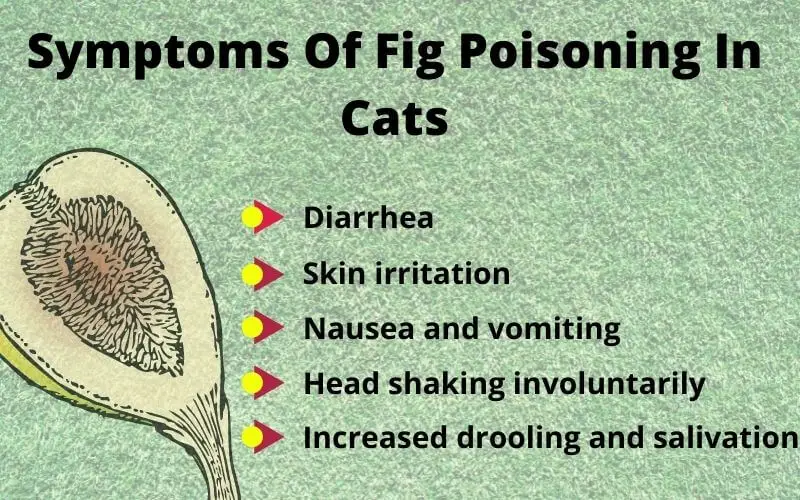Fig is a small nutritious fruit filled with essential vitamins and minerals. It has several small seeds within it and an edible peel. Can Cats Eat Figs? Meanwhile, the flesh of this fruit has a mild and sweet taste. Figs and their leaves have potential health benefits as well.

Can Cats Eat Figs?
They help the Gastrointestinal tract in digestion and absorption, decrease risks of heart-related conditions, and help manage blood glucose levels. However, the real question is if figs are as nutritious to cats as they are to humans. Let’s find out.
Do Cats Like Figs?
Figs are definitely not on the top of a cat’s favorite food item list. The ripened fig isn’t harmful to cats, but it’s still not recommended daily or even weekly meal options. They can be given once in a while, but that too under proper supervision.
Fruits that are considered safe for a cat include:
- Apples
- Strawberries
- Blueberries
- Bananas
Are Figs Toxic To Cats?
Many fruits and vegetables that are completely safe for humans can be toxic to animals. Figs lie in the toxic category. The leaves of its plants, sap, peels, and seeds are toxic and irritating for cats.
The toxicity of figs is low to mild/moderate, and your cat won’t instantly die after eating it, but it will exhibit signs and symptoms of fig poisoning. If such a case is suspected, you should immediately take your cat to the vet. A delay in seeking medical care can prove to be fatal.
Are Figs Bad For Cats?
Yes, figs are not the most healthy option for cats. They can induce a hypersensitivity reaction in their body, which will require urgent treatment and management.
Symptoms Of Fig Poisoning In Cats:
The signs and symptoms of fig poisoning don’t manifest instantly. They may take a few hours to develop. These include:

- Nausea and vomiting
- Increased drooling and salivation
- Head shaking involuntarily
- Diarrhea and other gastrointestinal problems
- Skin irritation, which will be markedly visible
All of these symptoms are not necessary to be present at a single time. There is nothing to worry about, as your cat is expected to make a full recovery with proper treatment and care.
What Are The Causes Of Fig Poisoning?
Fig poisoning occurs when your cat eats any part of the fig, be it the seeds or the leaves of its plants. Fig trees are often kept as indoor plants in homes and offices for their evergreen property. So if you have a pet cat, keeping a fig tree in your home might not be the best idea.
The pathology behind this poisoning is that there are very harmful substances found in the fig plant, ficin, and ficusin. These substances damage the DNA within the nucleus. DNA is considered the most essential part of a cell. It has all the information stored in it. With that getting affected, the cell starts losing its function. The highest concentration of these toxins is in the sap present in the leaves and the branches of the tree.
read can cats honeydew
Some more harmful substances present in figs are ficain and psoralen. Ficain can cause irritation to the skin, eyes, nose, and lungs, while the psoralen can cause nausea and pruritus. This is why we emphasize keeping your cat away from unripe figs.
What Is The Treatment Of Fig Poisoning?
Fig poisoning should be dealt with in the emergency room on a priority basis. As in any case of poisoning, the first step is stabilizing the patient. This involves bringing the vitals (heart rate, respiratory rate, pulse) back to normal.
This is done by administering emergency drugs via the intravenous route (for direct access to the circulation). This all takes a lot of time, and even after the drugs have been administered, this may require multiple nights at the hospital.
Once the vitals have been brought back to normal, the next step is to remove any additional figs from the system. The only way to do this is by bringing it out of the mouth, and thus vomiting is initiated by administering a fluid with a small percentage of hydrogen peroxide.
Caution: You should never try to induce vomiting at your home, as this might be fatal if not performed correctly. This should always be done by a professional veterinarian.
If your cat has ingested a huge amount of fig, one additional step needs to be performed in addition to the induction of vomiting, which is the administration of activated charcoal. This is done through a tube inserted via the mouth to the stomach. Activated charcoal is used in other poisoning cases as well. It helps neutralize the toxins by absorbing the harmful chemicals and thus neutralizing their effect.
Frequently Asked Questions
Are fig trees and their leaves toxic for cats?
Fig trees and their leaves are much more toxic to cats than the fruit itself. Cats love to brush their bodies against rough surfaces, but one thing they shouldn’t be doing at all is brushing against a fig plant. As a pet keeper, it is your job to ensure this doesn’t happen.
The wood and the plant’s leaves contain certain chemicals that can induce a hypersensitivity reaction in cats. This causes their fur to develop irritation and sensitivity and eventually causes blister formation.
Have a look at can cats eat dates
Can cats eat fig jam?
Like cats are not fond of fig fruit, they don’t treat fig jam very differently. You won’t see any cat rushing towards a fig jam jar. It doesn’t contain a lot of nutrition for the cat and shouldn’t be included in the daily diet.
Can cats eat dried figs?
Dried fruit can be safe for cats if used once in a while. Dried figs have fewer toxins than fresh fruit, but dried fruits are loaded with sugar, so they should not be fed too often. Nevertheless, they can be a source of added energy, fiber, minerals, and vitamins to your cat if given in minimal amounts.
Can cats eat fresh figs?
Ripened figs are comparatively a little better tolerated by cats. They still have the potential to induce adverse effects in the animal but to a lesser extent. To be safe, they should not be fed to cats often or at all. Maximum once a month can be tolerated.
Conclusion:
Although a very nutritious fruit for human beings, figs are not that nutritious for cats. You should keep your pet away from this fruit, especially its plant. In case of fig poisoning, treatment is possible, and your cat can recover fully provided that the cat is taken to the vet as soon as possible.





Leave a Reply